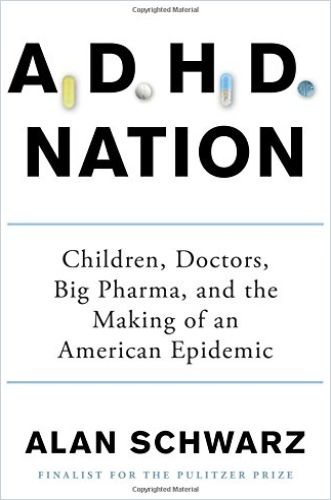New York Times journalist and Pulitzer-Prize nominee Alan Schwarz presents the definitive history of attention deficit and hyperactivity disorder (ADHD), the battles over identifying and naming it, and how drug companies sought to profit from it.

The History of ADHD
New York Times reporter Alan Schwarz covers the history and treatment of attention deficit and hyperactivity disorder (ADHD), including the role of pioneering experts and the influence of the pharmaceutical industry. Schwarz’s balanced discussion of ADHD will interest patients, parents, mental health professionals, teachers and policymakers.
Attention Deficit and Hyperactivity Disorder (ADHD)
Schwarz reports that the first recorded description of ADHD goes back to “Fidgety Philip,” a poem German psychologist Heinrich Hoffmann wrote about his three-year-old son in 1845. The chorus says, “But fidgety Phil, he won’t sit still.”
Our culture’s handling of the disorder could very well be diagnosed with ADHD itself.Alan Schwarz
Emma Pendleton Bradley paved the way for the facility that first treated childhood mental disorders, including ADHD, in the United States. Born into wealth in 1879, Emma contracted encephalitis at age seven. It inflamed her brain, causing epilepsy, palsy and mental retardation. When her father George died in 1906, he left his fortune to build a facility for mentally challenged children.
The Emma Pendleton Bradley Home –now Bradley Hospital – opened in 1931 and took in dozens of children. Bradley’s grandnephew, Harvard Medical School graduate Dr. Charles Bradley, became the center’s first director. In the 1930s, Smith, Kline & French Laboratories (SKF) formulated “benzedrine sulfate,” which it sent to Dr. Bradley and other physicians to treat mentally ill children. Bradley conducted a trial on 30 children – nine girls and 21 boys – ages five to 14. The results were astounding.
Bradley noticed improved attention spans, concentration and schoolwork, and found the children calmer and happier. His results, published in the November 1937 issue of the American Journal of Psychiatry, caught the attention of Drs. Leon Eisenberg and Keith Conners at Johns Hopkins. In 1962, they began clinical trials with the drug methylphenidate hydrochloride – better known as Ritalin.
The “Conners Scale”
Eisenberg and Conners ran a double-blind clinical trial using Ritalin with 78 kids. Those who took Ritalin were more alert and less impulsive; they learned more easily. However, they suffered side effects, including lost appetite, insomnia and heightened anxiety.
ADHD has become…the most misdiagnosed condition in American medicine.Alan Schwarz
Conners developed the Conners Scale, a 39-question form teachers filled out to record their observations about a child. Doctors used it to standardize diagnoses. The scale measured other people’s perceptions of a kid’s behavior – not the behavior itself. This facet of ADHD research raises a crucial question regarding diagnosis and treatment.
Shifting Names
Experts criticized the diagnosis then in use, “minimal brain dysfunction,” or MBD. Dr. Virginia Douglas, one of the few women then practicing in the male-dominated field of child psychiatry, suggested that the problem wasn’t impulse control or hyperactivity, but lack of attention. Using her phrasing, the American Psychiatric Association’s 1980 edition of the Diagnostic and Statistical Manual of Mental Disorders (DSM) included a new category: Attention deficit disorder (ADD).
Parents launched a backlash against Ritalin by suing doctors for not disclosing some potential side effects, such as nervous tics and hallucinations. From 1987 to 1991, Ritalin use in Baltimore decreased by almost 50% in the wake of a lawsuit. Prescriptions for Ritalin fell across the country.
Parents and physicians seemed to latch on to the diagnosis, with little attempt to sort out the complicating specific problems in their life. Letter from Dr. Keith Conners
The 1987 edition of the DSM changed the nomenclature to attention deficit hyperactivity disorder or ADHD. Parents of children with this disorder founded a support group called Children and Adults with Attention-Deficit/Hyperactivity Disorder (CHADD.) It became a powerful lobby. Today, parents, teachers, doctors and advocates must work together to understand ADHD in all areas, from causation to treatment.
Drug Wars
Roger Griggs, who started Richwood Pharmaceutical to buy companies that held undervalued drug patents, noticed that a prolific prescriber, pediatrician Ron Jones in Provo, Utah, dispensed the weight loss drug Obetrol to kids with ADHD. Griggs renamed Obetrol as Adderall and marketed it to child psychiatrists for ADHD patients.
A definitive ADHD study concluded that medicine like Ritalin was safe and less costly than cognitive behavioral therapy. The British pharmaceutical company, Shire, bought Richwood Pharmaceutical for $186 million.
Children with minimal brain dysfunction…usually needed these drugs. Hesitation to prescribe them merely prolonged unnecessary agony.Alan Schwarz
Drug companies ALZA, Novartis, Eli Lilly, and others sought profits in ADHD. Doctors hoped for an ADHD therapy that would last all day. ALZA debuted Concerta, basically a slow-acting Ritalin. Concerta rivaled Shire’s Adderall, then the most prescribed ADHD medication, with sales of $250 million in the year 2000. Shire responded with extended-release Adderall XR. Some prescribing doctors earned part of their income directly from drug companies.
The Future of ADHD
Pharmaceutical companies regarded adults with ADHD as an untapped market. Doctors wrote 5.6 million prescriptions to treat adult ADHD in 2007 and 16 million in 2012.
A proper diagnosis and treatment plan take time to develop, an effort that encompasses multiple sessions with patients and, if they are children, with the adults involved in their care, including parents, teachers, therapists and doctors.
A Definitive Overview
Alan Schwarz’s research and wide-ranging sources – including interviews with doctors, patients, parents, therapists and people from drug companies – result in a uniquely comprehensive overview. He has no axe to grind; he’s not writing with the emotion of a parent who has a child with ADHD or with the salesmanship of a pharma company rep with a treatment to hawk. Schwarz’s objective dispassion makes his report indispensable for anyone seeking to understand the social, medical and media trends that obfuscate discussion around ADHD. Schwarz keeps numerous contending viewpoints in balance as he searches for an elusive and perhaps ever-changing truth, making this the definitive work on the subject.
Alan Schwarz co-authored Once Upon a Game: Baseball’s Greatest Memories. Other books on ADHD include Driven To Distraction: Recognizing and Coping with Attention Deficit Disorder by Edward M. Hallowell, MD and John J. Ratey, MD; and You Mean I’m Not Lazy, Stupid or Crazy?! by Kate Kelly and Peggy Ramundo.











